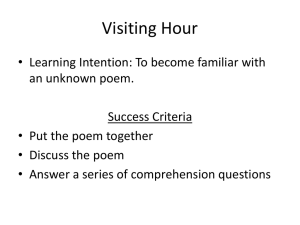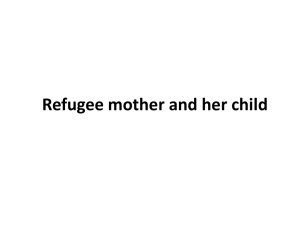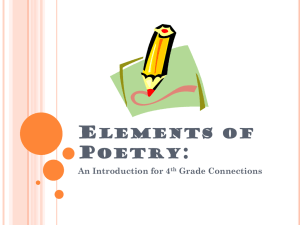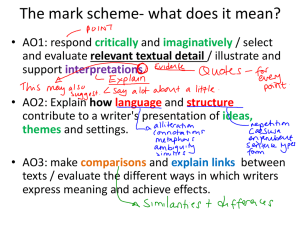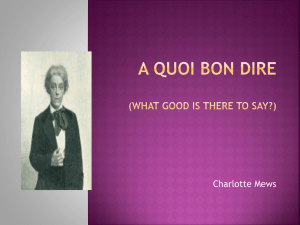The stanza
advertisement
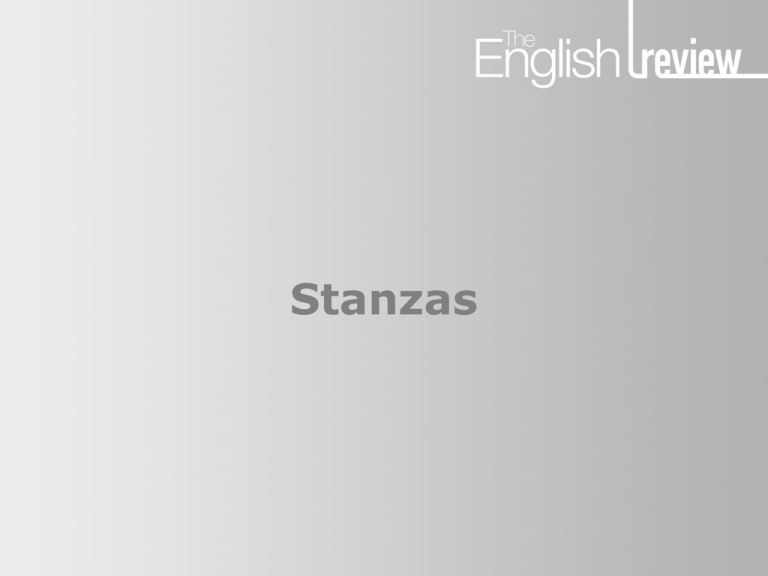
Stanzas Stanzas Stanza etymology (word origins) From the Italian for: ‘stopping place’, or ‘room’. The above terms are derived from the Latin verb meaning: ‘to stand’. Stanzas Stanza: definitions 1) A group of lines that helps to: break up and organise how the poem appears on the page. 2) A place where the reader stands and pauses. Stanzas Why pay attention to stanzas? A poet’s choice of stanzaic form is usually appropriate to his or her subject matter or theme. Considering how stanzas develop can help you follow the development of thoughts and ideas in a poem. Once a stanzaic pattern is disrupted, this usually serves some expressive purpose — it often creates an interesting effect that is worthy of analysis. Stanzas Quatrains (1) Quatrain: a four-line stanza. The quatrain is one of the most common and versatile stanzaic forms in English poetry. Quatrains can be useful for narrative poems (poems that tell stories). Stanzas Quatrains (2) Here is a quatrain from Coleridge’s The Rime of the Ancient Mariner. It narrates the action after the Mariner has blessed the water snakes: ‘The self-same moment I could pray; And from my neck so free The Albatross fell off, and sank Like lead into the sea.’ Stanzas Quatrains (3) Note the appropriateness of this stanzaic form: the single rhyme per stanza (on lines 2 and 4) allows the poet flexibility. Yet the expectation of this rhyme (and each stanza’s predictable rhythm) sets a pattern that aids the poem’s narrative drive and helps sustain the reader’s sense of expectation. Stanzas Taking it further: varieties of quatrain The quatrain quoted from The Rime of the Ancient Mariner is typical of the ballad form. Why not find out more about ballads and their features, including meter (rhythm) and line length? Think of other poems that you know which are comprised of quatrains. To what extent do they have narrative features, or are the quatrains being used to serve other poetic aims? Stanzas Taking it further: shifting stanzas Consider any variations within the stanzaic form. If there is a shift from quatrains to another stanzaic form, what are the effects of such a shift? For example, in a poem by Paul Muldoon entitled ‘The Sightseers’ two quatrains allow the speaker to narrate a story of him and his family going on an outing together — to see the first roundabout in mid-Ulster. After this revelation of their unusual destination, Muldoon shifts to using tercets (three-line stanzas). Stanzas Example: shifting stanzaic form The tercets allow the reader to register a shift in tone, subject matter and narrative perspective as the speaker recounts a story told by his uncle Pat. Despite the fluency of the narrative (which is enhanced by enjambment) the shorter stanza provides a stopping point — and more white space — to allow the reader to pause and consider these new and more disturbing events: ‘Uncle Pat was telling us how the B-Specials Had stopped him one night somewhere near Ballygawley And smashed his bicycle’ Stanzas Example: shifting stanzaic form Muldoon’s final tercet allows the poem to climax with a potent and lingering image of violence and oppression: ‘And made him sing the Sash and curse the Pope of Rome. They held a pistol so had against his forehead There was still the mark of an O when he got home.’ Note also the effects of the full rhyme (in an otherwise unrhymed poem), which help to give the image further impact. Stanzas Examples: shorter stanzas (1) As we have seen from the previous example, tercets can be used to narrate, but often in such a way that allows images or events to stand out. In some cases, however, the primary focus is on the image. ‘Fan piece, for her Imperial Lord’ by Ezra Pound is comprised of a single tercet; first it lingers on an image, then it suggests the significance of that image in a story: O fan of white silk, You also are laid aside. clear as frost on the grass-blade, Stanzas Examples: shorter stanzas (2) Here is another short poem by Pound, this time in a two-line stanza. Note that this time no narrative is suggested; the image is simply left to speak for itself: In a Station of the Metro The apparition of these faces in the crowd; Petals on a wet, black bough. Stanzas Conclusions Considering the types of stanza used can help you to explore meaning and effects in poetry. Noticing when a stanzaic pattern changes can often lead to interesting observations and analysis. Explore other related features as you analyse stanzas. You might, for example, consider rhyme, rhythm, end-stopping and enjambment.




